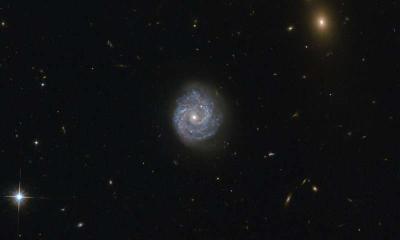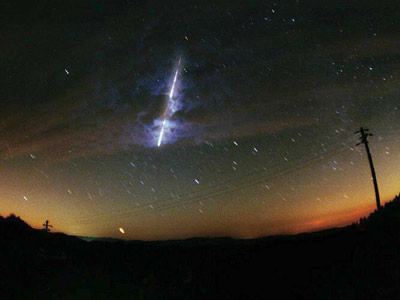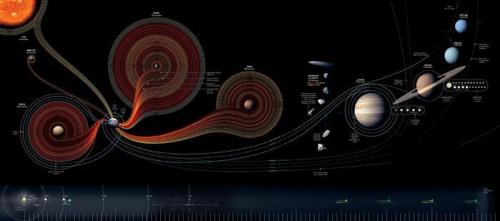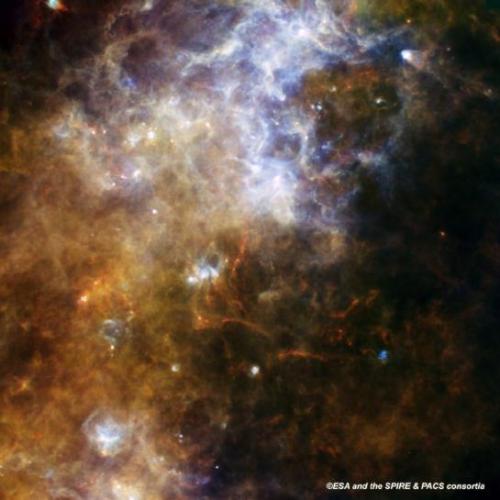Topic: Space - on July 3, 2010 at 10:14:00 AM CEST
Russisches Raumschiff verfehlt ISS
Außer Kontrolle: Ein russischer Weltallfrachter sollte der Internationalen Raumstation ISS Proviant bringen, flog aber drei Kilometer am Ziel vorbei. Kurz vorm Andocken versagte offenbar der Autopilot, jetzt wird der Fehler gesucht.
Washington/Moskau - Ein unbemannter Versorgungstransporter ist kurz vor dem Andocken an die Internationale Raumstation ISS außer Kontrolle geraten. Der russische Raumfrachter "Progress 38" habe die ISS bei seinem Anflug aus unbekanntem Grund um rund drei Kilometer verfehlt, teilte die US-Raumfahrtbehörde Nasa am Freitag mit.
... Link (0 comments) ... Comment
Topic: Space - on June 20, 2010 at 10:19:00 AM CEST
Spitzer Telescope Witnesses Star Being Born
Astronomers have glimpsed what could be the youngest known star at the very moment it is being born. Not yet fully developed into a true star, the object is in the earliest stages of star formation and has just begun pulling in matter from a surrounding envelope of gas and dust, according to a new study that appears in the current issue of the Astrophysical Journal.
The study’s authors—who include astronomers from Yale University, the Harvard-Smithsonian Center for Astrophysics and the Max Planck Institute for Astronomy in Germany—found the object using the Submillimeter Array in Hawaii and the Spitzer Space Telescope. Known as L1448-IRS2E, it’s located in the Perseus star-forming region, about 800 light years away within our Milky Way galaxy.
... Link (0 comments) ... Comment
Topic: Space - on April 23, 2010 at 1:18:00 PM CEST
'Spectacular' First Images from New Solar Observatory Released
The first images of the sun beamed home from NASA's newest solar observatory have wowed mission scientists with their extraordinary detail and unexpected findings.
NASA released the first new images today from the Solar Dynamics Observatory, a probe launched on Feb. 11 to peer deep into the layers of the sun, monitor solar storms and investigate the mysteries of the sun's inner workings.

... Link (0 comments) ... Comment
Topic: Space - on April 23, 2010 at 1:16:00 PM CEST
Hubble's Late Teen Years: It Was the Best of Times, It Was the Worst of Times
To celebrate the 20th anniversary of the Hubble Space Telescope, for ten days, Universe Today will feature highlights from two year slices of the life of the Hubble, focusing on its achievements as an astronomical observatory. Today's article looks at the period April 2006 to April 2008.
... Link (0 comments) ... Comment
Topic: Space - on April 23, 2010 at 1:13:00 PM CEST
Spektakuläres Jubiläumsbild von "Hubble"
Anlässlich des 20. Jubiläums des Weltraumteleskops "Hubble" hat die US-Raumfahrtbehörde NASA eine neue Aufnahme des fliegenden Observatoriums veröffentlicht. Sie zeigt eine gewaltige Gassäule in einer Brutstätte neuer Sterne.

... Link (0 comments) ... Comment
Topic: Space - on April 22, 2010 at 10:25:00 AM CEST
Skywatchers set for meteor show
Stargazers are preparing for a sky show as the annual Lyrids meteor shower gets underway on Wednesday.
The shower is named after the constellation Lyra, from which the meteors appear to originate.
The meteor shower peaks early on Thursday 22 April (GMT), when 10-20 meteors per hour are expected to be visible under favourable conditions.
... Link (0 comments) ... Comment
Topic: Space - on January 11, 2010 at 11:08:00 AM CET
Schwarzes Loch frisst Weißen Zwerg
Weltall, 10.01.2010 – Auf einer Tagung der American Astronomical Society (AAS) am 4. Januar berichteten Wissenschaftler über die Entdeckung einer Röntgenstrahlungsquelle im Spiralnebel NGC 1399 (im Sternbild Schütze, etwa 65 Millionen Lichtjahre von unserem Sonnensystem entfernt), die von einem Schwarzen Loch auszugehen scheint. Aufgrund der Analyse der Bilddaten des Röntgenteleskops Chandra, das sich auf einer Umlaufbahn um die Erde befindet, kamen sie zu dem Ergebnis, dass ein Schwarzes Loch mittlerer Größe die Bahn eines Weißen Zwerges gekreuzt hat und dabei ist, diesen Kleinstern zu verschlingen. Dabei wird Röntgenstrahlung freigesetzt, die von dem Weltraumteleskop aufgezeichnet werden kann.
... Link (0 comments) ... Comment
Topic: Space - on November 15, 2009 at 12:51:00 PM CET
Leoniden Meteorsturm
Voraussetzung für einen Meteorsturm ist, wie auf der Vorseite erläutert, dass die Erde mit einer jungen, dichten Materiewolke kollidiert. Es ist wenig überraschend, dass dies prinzipiell nur dann der Fall ist, wenn sich auch der Komet 55P/Tempel-Tuttle in Erd- bzw. Sonnennähe befindet. Da die Bahnen der Trümmerwolken aber nicht ganz identisch mit der des Kometen sind und sich unter dem Schwerkrafteinfluss der Planeten - vor allem Jupiter und Saturn - verändern können, treten auch in den Jahren vor und nach der Perihelpassage von 55P/Tempel-Tuttle Begegnungen mit dichten Materiewolken ein.

... Link
Topic: Space - on November 15, 2009 at 12:48:00 PM CET
The Leonid Meteor Shower 2009
NASA's Fluxtimator helps calculate the meteor shower activity in your area. There will be one of the biggest meteor shower events of our lifetime, the Leonid Meteor shower of 2009. Start time: this Monday November 16, 2009 at 11:00pm EST. End Time: Tuesday, November 17, 2009 at 4:00am EST (best 2am to 4 am EST). An Atomic Age song in mp3 to celebrate: What Is A Shooting Star.
metafilter.com Calculate what is the best location for viewing the upcoming meteor shower
... Link
Topic: Space - on October 16, 2009 at 11:01:00 AM CEST
Student sends camera into stratosphere
Geoff McCormack looked at projects where people had attached digital cameras to weather balloons and decided to take it a step further. Fortunately, Deakin University was supportive of his unusual final-year project.
I had always wanted to build something and attach it to a balloon to see where it went but had never found the time to work on it. I had seen pictures from projects overseas where people had attached digital cameras to weather balloons and I thought I'd take it a step further with a custom-designed data-logger and control system. Fortunately, Deakin University was supportive of my unusual final-year project.

smh.com.au Teens capture images of space with £56 camera and balloon
... Link
Topic: Space - on October 12, 2009 at 11:38:00 AM CEST
50 Years of Space Exploration
Don’t miss the original version (3861×1706px)

... Link
Topic: Space - on October 3, 2009 at 1:02:00 PM CEST
The Milky Way unveiled as we have never seen it before
Herschel has recently achieved another major milestone in the currently ongoing performance verification phase. Building on the already demonstrated photometric capabilities of the PACS and SPIRE science instruments employed in the 'sneak preview' and 'first-light' observations, for the first time Herschel has now observed in the 'SPIRE/PACS parallel mode'.

... Link










